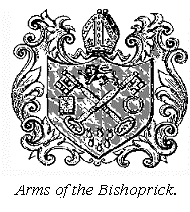WATERFORD DIOCESE
The city is the seat of a diocese, founded originally about the close of the 11th century by the Ostmen of Waterford, soon after their conversion to Christianity; for which purpose they chose Malchus, who had been a Benedictine monk of Winchester, and sent him to England to be consecrated by Anselm, Archbishop of Canterbury. Malchus entered upon his episcopal office in 1096, and died in 1110; of his two immediate successors, nothing worthy of notice occurs; after the distribution of the four palls by Cardinal Paparo, Augustine, the third in succession, was appointed bishop in a council at Windsor, in 1175, and sent by the king to Ireland, to be consecrated by his proper metropolitan, Donat, Archbishop of Cashel. David, the second in succession to Augustine, was consecrated in 1204. and, in addition to his own, seized the temporalities of the adjoining see of Lismore, but was assassinated in 1209; and Robert, who succeeded to the prelacy in 1210, pursuing the same policy as his predecessor, laid the foundation of continual feuds between the two sees, which were carried on with fierce and rancorous hostility.
soon after their conversion to Christianity; for which purpose they chose Malchus, who had been a Benedictine monk of Winchester, and sent him to England to be consecrated by Anselm, Archbishop of Canterbury. Malchus entered upon his episcopal office in 1096, and died in 1110; of his two immediate successors, nothing worthy of notice occurs; after the distribution of the four palls by Cardinal Paparo, Augustine, the third in succession, was appointed bishop in a council at Windsor, in 1175, and sent by the king to Ireland, to be consecrated by his proper metropolitan, Donat, Archbishop of Cashel. David, the second in succession to Augustine, was consecrated in 1204. and, in addition to his own, seized the temporalities of the adjoining see of Lismore, but was assassinated in 1209; and Robert, who succeeded to the prelacy in 1210, pursuing the same policy as his predecessor, laid the foundation of continual feuds between the two sees, which were carried on with fierce and rancorous hostility.
Stephen of Fulburn, who was consecrated in 1273, was, in the following year, made treasurer and afterwards Lord Justice of Ireland, during which time he caused a new kind of money to be coined; and during the prelacy of Thomas Le Reve, who succeeded in 1363, the sees of Lismore and Waterford were consolidated by Pope Urban V., and this union, which had been long contemplated and frequently attempted without success, was confirmed by Edward III. Hugh Gore, who was consecrated Bishop of the united sees in 1666, expended large sums in repairing and beautifying the cathedral, and bequeathed £300 for bells for the churches of Lismore and Clonmel, and £1200 for the erection and endowment of an almshouse for ten clergymen's widows, to each of whom he assigned £10 per annum.
Nathaniel Foy, who was made bishop in 1691, greatly improved the episcopal palace, and bequeathed funds for the erection and endowment of a school for 50 children, afterwards extended to 75, and for the improvement of the estates, the surplus funds to be applied to clothing and apprenticing the scholars. The two sees continued to be held together till the passing of the Church Temporalities Act in the 3rd and 4th of William IV., when, on the decease of Dr. Bourke, both were annexed to the archiepiscopal see of Cashel, and the temporalities became vested in the Ecclesiastical Commissioners.
The diocese is one of the eleven that constitute the ecclesiastical province of Cashel, and comprehends the eastern portion of the county of Waterford; it is 13 miles in length and 9 in breadth, comprising an estimated superficies of 31,300 acres. The lands belonging to the see comprise 8000 acres; and the gross revenue of the united sees, on an average of three years ending Dec. 31st, 1831, amounted to £4323. 7. 1. The chapter consists of a dean, precentor, chancellor, treasurer, and archdeacon, who has no vote. Formerly there were the prebendaries of Kilcornan, Rossduffe, Corbally, and St. Patrick's, Waterford, and four chaplains; and about the beginning of the 13th century, King John endowed the cathedral with lands to the value of 400 marks, for the support of 12 canons and 12 vicars; but the estates were so wasted in the different wars, that the four great dignitaries had not sufficient to maintain them in comparative decency; and Edward IV., on their petition to that effect, granted them a mortmain licence to purchase lands of the yearly value of 100 marks.
The Economy Fund, in 1616, amounted to 100 marks; at present it is £144 per annum, a sum very insufficient for the repairs of the cathedral and the payment of the salaries of the choir and other officers of the cathedral. The consistorial court consists of a vicar-general, surrogate, registrar and deputy-registrar, apparitor, a proctor of office, and two other proctors. The diocese contains 34 parishes, comprised in 13 benefices, of which 11 are unions of two or more parishes, and two single parishes; of these, 4 are in the patronage of the Crown, 8 in that of the Bishop, and the remaining one wholly impropriate; the total number of churches is 8, and of glebe-houses, 7.
County Waterford | Waterford City | Waterford City Topography | Waterford Trade | Waterford Harbour | Waterford Charter | Waterford Diocese | Waterford Churches | Waterford City Geology | Waterford Parishes | Waterford Schools | Waterford Hospitals | Waterford City Antiquities
